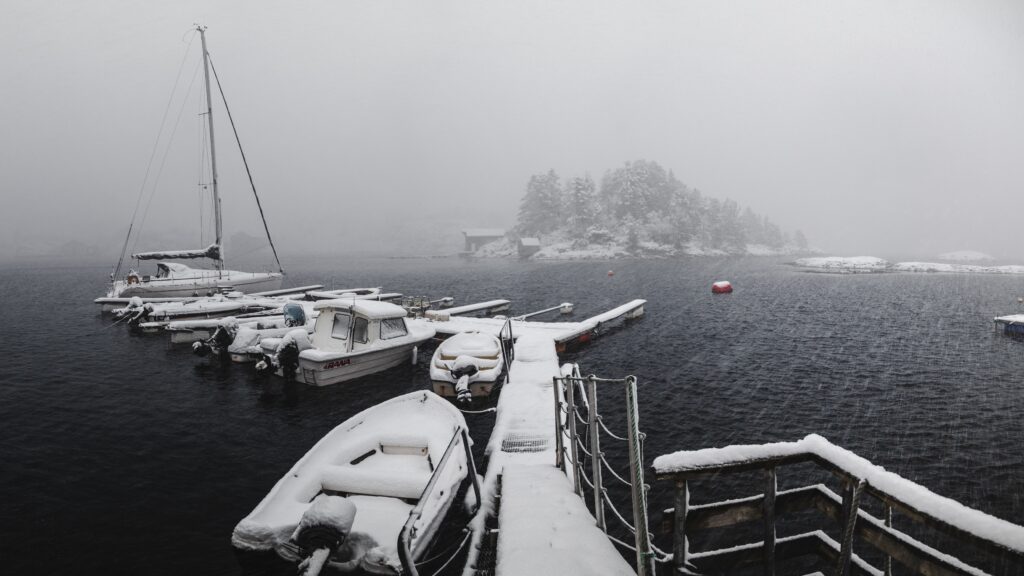Seven Tips & Tricks to Safely Enjoy Cold Weather Boating
It’s true: winter is almost over — but the cold weather boating season is still in full swing! While many boaters in the colder parts of the country do their due diligence in winterizing and storing their boats during the winter and into the spring, many still use their beloved vessels for fishing and leisure during even the coldest months of the year.
Cold weather boating season can be an exhilarating experience. In the middle of winter, you’ll find the water far less crowded, with only the bravest individuals enduring those stiff winds and freezing spray. And, depending on where you’re located, the cold weather boating season might be fairly mild, allowing you to properly take in the changing scenery and enjoy some winter fishing opportunities.
But cold weather boating isn’t for the faint of heart. It requires careful planning, a fully-serviced and safe watercraft, and the right gear. Here are the best ways to have a really good time out on the water, regardless of what the thermometer is reading on any given day.
Have a Float Plan
Filling out a float plan and leaving it with friends and family before you head out for a day on the water will give both you and your loved ones peace of mind to be able to enjoy your adventure in the off-season. Since there won’t be nearly as many boaters out and about during the colder season, it’s very important to let people know where you’re headed, how long you plan to be away, and what to do if you haven’t checked back in with them during a certain time period.
A good float plan will outline your journey for the day with distinct departure times, destinations, and return times. It will also include the make, model, size and capacity of your boat, as well as the contact information of everyone onboard. Be sure to include the local coast guard’s contact information as well.
→ Morningstar Marinas Tip: Download the coast guard’s official float plan template here to make things even easier!
Dress for Success
Regardless of what temperature the day starts at, air temperature out on the water can change dramatically, with wind speeds making things feel below freezing at a moment’s notice. Even if it feels ridiculous to board your boat with a heavy winter jacket, balaclava, gloves, lots of extra layers, and heavy blankets to boot, you can never be too safe. It’s better to have some extra layers to bundle up with if things take a turn than be stranded out on the water, freezing!
It may also make sense to invest in survival wear if you plan to boat year-round on a regular basis. Things like a float coat or survival suit could make the difference in saving your life under dire circumstances!
Wear Your Life Jacket
Regardless of whether or not there are signs of ice in the water, water at even 60 degrees can put you at risk of shock and hypothermia if you were to fall overboard, affecting your ability to function. Wearing your life jacket can literally save your life in the colder months, when the water has a greater effect on your heart, lungs, and muscles within an instant. Wearing your PFD will help to keep you afloat, even when the cold has shocked your body and incapacitated your ability to swim.
Pack a Snack
Come prepared with snacks for the whole outing – they can be the real winners in keeping all your passengers satisfied and away from potential motion sickness or seasickness. Both of these ailments are all the more common in cold, windy, choppier water conditions that frequently occur during the winter months.
Service Your Boat All Season Long
Winterization is an important part of keeping your boat in the best shape possible during the colder months. It ensures all fluids have been drained from the boat’s motor, with antifreeze put in its place to prepare the engine and other water-bearing systems for freezing temperatures. If you decide to de-winterize your boat to use it during the colder months, don’t forget to re-winterize it ahead of the next big freeze! There’s nothing worse than a cracked engine to ruin the summer season before it even begins!
Check your batteries just like you would a car battery during the colder months, making sure it’s fully charged so you won’t be stranded out on the water. Do a proper inspection of the watercraft as you would before heading out on any occasion.
Safety First
Cold weather boating safety is similar to all the other parts of the year you spend on the water: manage your speed, keep your eyes ahead, and don’t let anyone fall overboard. Watch out for things in the water, particularly ice, as large chunks can lurk just below the surface of the water. Also keep an eye out for ice on docks, decks, mooring lines and wires, as this makes things that much harder to work with. Carry a radio with you in case of emergency.
Have Fun!
Cold weather boating is an exciting opportunity for captains and passengers alike to see the water from a whole new vantage point. With the proper preparation, safety plans, and gear, you can enjoy your boat during all four seasons of the year! In the end, it comes down to three very important things: stay warm, stay safe, and, of course, have fun!
At Morningstar Marinas, we pride ourselves on the community of boaters we’ve created across the Southeast’s top boating destinations. Our facilities and services paired with our friendly and knowledgeable team members will help you quickly and efficiently get out there on the water, so you can start having fun! Morningstar Marinas is more than just a place to store your boat — we’re your home away from home.

